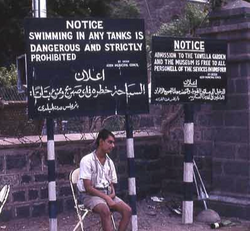Tawila Tanks
The Tawila Tanks, also known as 'Aden Tanks', the 'Cisterns', 'Queen of Sheba Tanks' 'Solomon's Wells' or 'Solomon's Tanks', are located at the head of Tawila Valley in the southwest sector of Crater. They are considered one of the greatest historical engineering feats in South Arabia, likely built and developed during the rules of Banu Zuraia’, the Roulades, the Tahirides and the Ottomans and mentioned in the ancient Al-Musnad inscriptions. However, not much is accurately known of their history.
The system of tanks were designed both to collect the scarce rain water and divert runoff to protect the city of Crater in case of heavy rains and sweeping floods. They were excavated out of solid rock and lined with a thick coat of fine stucco, resembling marble. However, at some unknown point in time the tanks became completely buried, filled with stones and soil washed down from the mountain slopes by the rains.
Credit has been attributed to Lieutenant Robert Lambert Playfair, when Assistant Resident in Aden in 1854, for accidentally rediscovering the tanks. However, Commander Haines was aware of them when he visited Aden in 1835 whilst surveying the South Arabian coast.

In 1856 the restoration of these magnificent public works was commenced and on 23rd October 1857 the tanks which had been cleared were filled with rainwater for the first time since restoration. Subsequently, with more tanks restored, they were filled again in May 1864, May 1870 and September 1877.
The lower circular tank, named Playfair Tank, was the last to be restored. There were originally 53 tanks but today only 13 remain. The aggregate capacity for all the tanks exceeds twenty million imperial gallons. Up to 31st March 1874 the restoration and repair costs had reached £37,000.
Today any water in the tanks is used to a small extent to irrigate the Tawila Gardens, which offer a relatively cooling respite from the oppressive heat of the town. Local women can still be seen today collecting water from the tanks.
The Arabs believed that each time the tanks became full there must be three deaths by drowning. One such incident witnessed the drowning of an Indian overseer who was seen floating head down in one of the larger tanks while a hundred people stood on the bank within a few feet of him. They could easily have saved him, but would not touch him as it was believed to be unlucky to touch the dying.
Whilst the tanks contained water the condenser on Sirah Island (built 1869) for producing distilled water was not used. The tank water was issued to the troops and also to the public at a cost of 1 rupee per 100 gallons or 8 annas (nearly one shilling sterling) for a skin containing 5 gallons.
Aden's average rainfall was only 3" but it rained perhaps only twice every two years. When the tanks were filled the water was sold by auction and was carried it away in tins, goatskins, or water carts.
The rainfall was always a welcome treat for local children who would be seen swimming (yes swimming) in the flooded streets of Crater. The rains were not so welcomed by those who lived in makeshift wood and cardboard shelters on the mountain slopes as the torrential rain would sweep their ramshackle homes into the valleys below.
 |  |  |
|---|